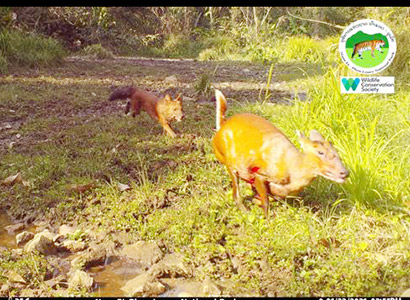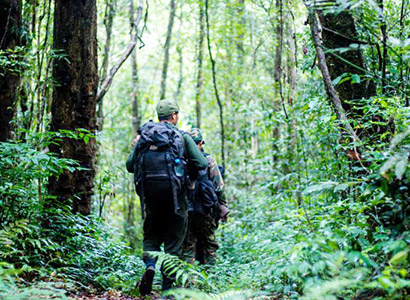Laos adopts the Protected Areas new decree to safeguard and restore biodiversity
After three years in the making, the Prime Minister, Mr Sonexay Siphandone adopted the new decree on protected areas in Laos on 20 June 2023, marking a major milestone for better management and governance of these biodiversity-rich zones. The Wildlife Conservation Society (WCS) worked hand in hand with the Lao government, protected area practitioners and key stakeholders to strengthen this important national legislation, within the framework of the ‘Ecosystem Conservation through Integrated Landscape management in the Lao PDR (ECILL) project’, financed by the Agence Française de Développement (AFD) and the European Union (EU). Manoly Sisavanh, Deputy Country Director of WCS Lao PDR, looks back on this success.
 |
What was the situation in Laos before the decree was passed?
Manoly Sisavanh: Since declaring independence in 1975, Laos has included forest protection and biodiversity conservation in its national development agenda. The first evidential actions were carried out in the 1980s through surveying the country’s wildlife and their habitats with the support of development partners and NGOs.
The first national conference on forestry in 1989 acknowledged that the alarming rate of deforestation in Laos posed serious negative impacts on biodiversity and natural habitats that could drive native species to extinction. So, in 1993 the government of Laos established the first set of 18 National Protected Areas (NPAs) including the Nam Et-Phou Louey and the Nam Kading areas, where the ECILL project provides technical and financial support.
More NPAs were created from 1995 to date—making a total of 26 NPAs, of which six were declared ‘National Parks,’ a category of higher protection. To date, several laws have been added to the legal framework, most notable is the Forestry Law, under which the first Protected Area (PA) Decree No. 134 was issued in 2015 to regulate protected area management, protection, development, and use. Since 2016, the forestry sector has undergone progressive sectoral institutional and legal reforms.
These include the adoption of the Prime Minister’s Order No. 15 (2016) on increased strictness for timber businesses, the Penal Code (2017) provisions wildlife and forest-related criminal offenses and punishments, and the Prime Minister’s Order No. 05 (2018) on increased strictness for wildlife businesses in response to the CITES Article XIII compliance.
In 2019, the National Green Growth Strategy to 2030 and the new Forestry Law were adopted, which set more comprehensive frameworks and directions for the development of the first Decree on CITES implementation (2022), this new Decree on Protected Areas (2023), and the upcoming revised Wildlife Law and the new Forestry Strategy to 2035.
All these policies are set to fulfill the Lao PDR’s international commitments under Multilateral Environmental Agreements and national goal to achieve 70 percent closedcanopy forest cover and to conserve 70 percent of its total land area as forest areas—comprising Conservation Forests (aka. Protected Areas), Protection Forests, and Production Forest Areas.
What is the content of the new decree and how does it compare to the previous one?
Manoly Sisavanh: WCS was entrusted by the Department of Forestry to provide technical and scientific advice into the decree designing and drafting process and the overall protected area reform in Laos. In analysing the shortcomings of the 2015 Decree and the challenges manifested in the field by practitioners, the decree drafting committee introduced six key principles into the new decree. First of all, Protected Areas (PAs) lacked recognition, especially by other sectors.
 |
This decree raises the standard, priority, and profile of PAs to align with national goals and meet international standards. The new decree clarifies the Levels of PAs (national, provincial, district and village), Categories of PAs compatible with the IUCN standards, and the Zones within PAs (totally protected zone, controlled use zone and buffer zone), which allow better protection and control of the activities authorised in each.
Secondly, the decree aims to balance benefits between people and nature by involving the inhabitants of the surrounding villages in co-management of the PAs through the ‘Guardian Village’ approach. This approach requires the Guardian Village Conservation Contract that promotes PA communities’ participation and empowers them to jointly make decisions with PA Authorities about resource use and allocation which serve conservation and development objectives.
Third, the decree boosts the PA system governance and administration through a centralization approach at the level of the Ministry of Agriculture and Forestry for all National Protected Areas encompassing two or more provinces as well as for PAs of regional or international listing (i.e. UNESCO World Heritage, IUCN Green List, ASEAN Heritage Park).
All National PAs situated within a jurisdiction of one province and Provincial PAs will be managed at the Provincial Agriculture and Forestry Office level, and more flexible for District and Village PAs. Collaboration shall be promoted at central and sub-national levels with local administration offices and other sectors to harmonise and optimise PA land and natural resources use and allocation based on the ‘Integrated Landscape Management principles.
Fourth, PA Management Office (PAMO) is formalised as a ‘technical budget unit’ with stamp, mandate, and authority. Guardian Villages will be established and anchored in PA governance and administration. Each PA Management Plan and staffing will be set to better balance community engagement (i.e., outreach, participatory land use planning, livelihoods development) and resource protection. PAMOs will have the option to formalise collaboration and partnership with public, private and non-profit partners.
Fifth, the decree clarifies eligible PA use categories—for public, family, customary and business benefits—which entail rights and responsibilities of users. The decree also recognises land tenure of the inhabitants living inside PAs before its designation through the land registration and land titles or land use certificates for authorised customary land uses inside PAs. Finally, this decree looks carefully into balancing conservation with development aiming at applying the ‘Mitigation Hierarchy’ for business use to avoid or mitigate negative investment impacts on biodiversity and ecosystem services to achieve no net loss, or net gain. It also lays foundations towards innovative sustainable financing schemes to hopefully make PAs financially autonomous in the longterm. The options could include Payment for Ecosystem Services, Carbon Credits, nature-based tourism, Conservation Concession, Biodiversity Offsets, Debt-for-Nature Swab, and so more. Specific options for sustainable financing will be identified in the forthcoming ‘Roadmap for National Protected Area Management and Sustainable Financing’ to be developed by the Department of Forestry in partnership with WCS and relevant stakeholders under the ECILL.
What are the next steps for the implementation of this decree?
Manoly Sisavanh: Having supported the Department of Forestry throughout the decree development, WCS and all PA stakeholders (governments, development partners, private sector, NGOs/CSOs, academia and local communities) will have a crucial role in its dissemination and implementation. The next step to ensure proper implementation will be the preparation of the ‘Roadmap for National Protected Area Management and Sustainable Financing’, which will set out clear steps for the government to lead and PA stakeholders to support. The steps would include (i) preparing an action plan, (ii) establishing the roadmap formulating committee, (iii) preparing for the reorganisation of PA Management Offices as part of PA network, (iv) and developing sustainable financing schemes from both public and private sources that are suitable for Laos’s context. 3 This decree is a big bold step for biodiversity protection in the Lao PDR, and we are very proud to have been able to contribute to it within the framework of the AFD and EU-financed ECILL project. We look forward to continuing to work closely with the Lao government and all PA stakeholders to ensure its successful implementation.
By Times Reporters
(Latest Update June 28, 2023)
|